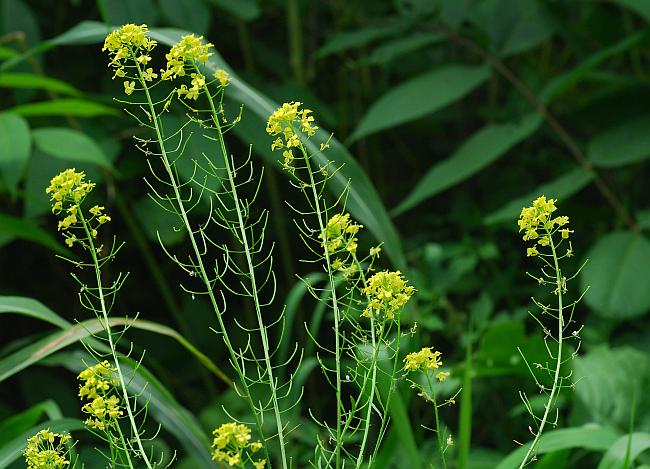Sisymbrium loeselii L.
Tall Hedge Mustard

Introduced
CC = *
CW = 5
MOC = 18
© SRTurner
Sisymbrium loeselii L.Tall Hedge Mustard | |
 |
Introduced CC = * CW = 5 MOC = 18 |
© SRTurner |
|
Family - Brassicaceae Habit - Annual forb. Stem - Strongly ascending to erect, to 1.5 m, usually hairy, sometimes nearly glabrous toward tip.
Leaves - Basal and alternate, short-petiolate, not clasping, lanceolate to triangular in outline, 2-15 cm long, pinnately lobed or divided into 3-9 lobes, these entire to toothed or lobed. Lowermost leaves hairy, uppermost sparsely hairy to glabrous.
Inflorescences - Panicles or racemes at branch tips, the flowers not subtended by bracts.
Flowers - Sepals 3-4 mm long, linear-lanceolate to narrowly oblong, erect or ascending, green. Petals 6-8 mm long, not lobed, yellow. Stamens 6. Styles 0.5-0.7 mm long at fruiting.
Fruits - Siliques 2.0-3.5 cm long, spreading or ascending at maturity, not appressed to the inflorescence axis, the stalk slender, noticeably narrower than the fruit. Seeds 40-60 per fruit, 0.7-1.0 mm long. Flowering - May - October. Habitat - Levees, crop field margins, pastures, railroads, open disturbed areas. Origin - Native to Eurasia. Lookalikes - S. altissimum, S. officinale. More broadly, several other mustards such as Barbarea vulgaris and Brassica spp. Other info. - This tall, gangly, introduced mustard is not particularly common in Missouri. It was first reported in the state in 1954 and has become more common since then, but is still largely restricted to railroads and agricultural fields. Most of its statewide distribution is from counties bordering the Missouri River, and the majority of those counties have reported the plant. Its broader distribution is widely scattered in the northern half of the continental U.S., ranging into Canada. Photographs taken off Route 118, Holt County, MO., 5-3-00 (DETenaglia); also along the Katy Trail near Augusta, St. Charles County, MO, 5-4-2011, and along the Katy Trail near Dutzow, Warren County, MO, 7-4-2014, 11-5-2019, and 4-22-2020 (SRTurner). |